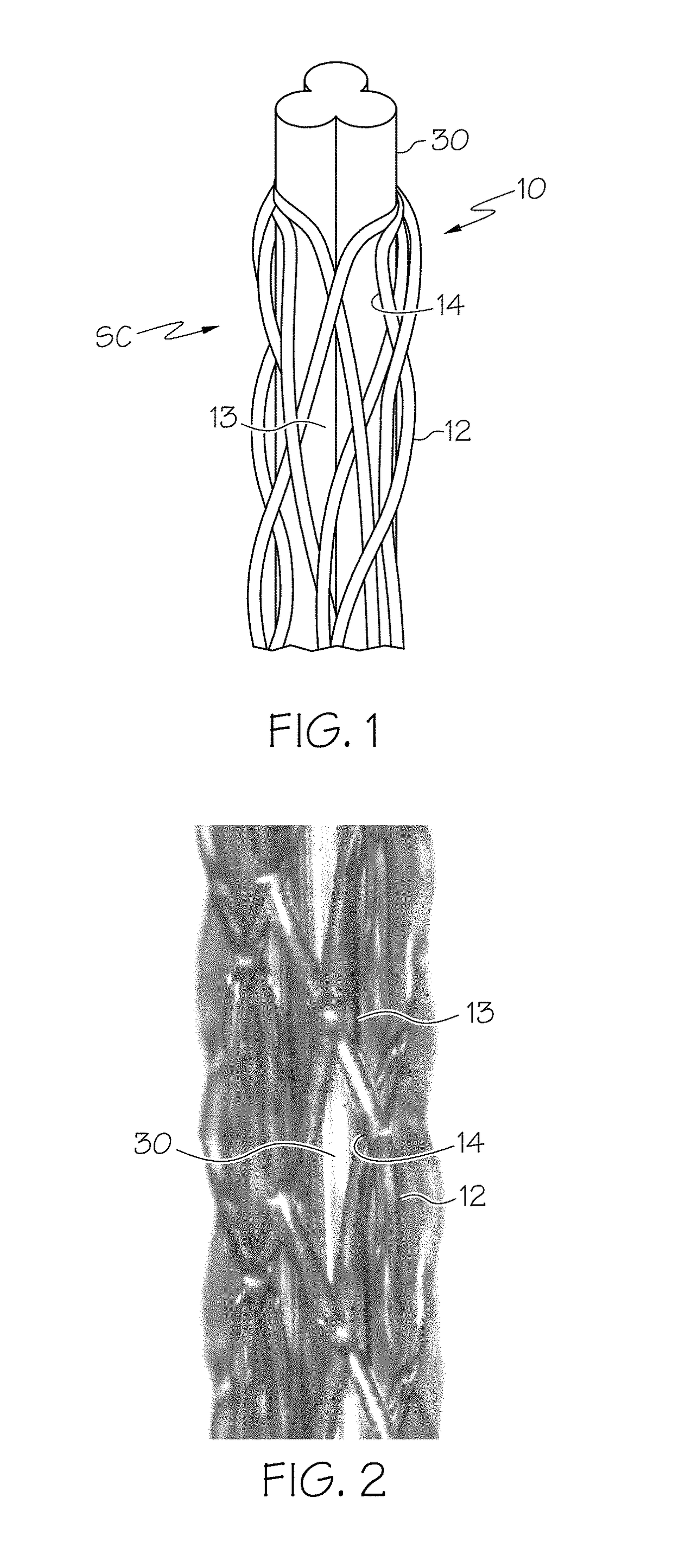Monofilament-reinforced hollow fiber membrane with scalloped lumen
a hollow fiber membrane and monofilament technology, applied in the field of macroscopy composite hollow fiber membranes, can solve the problems of poor permeation efficiency, lack of useful knowledge in avoiding damage to the membrane or maximizing permeation efficiency of the reinforced membrane, and poor performance of the reinforced membrane. , to achieve the effect of superior braided membran
- Summary
- Abstract
- Description
- Claims
- Application Information
AI Technical Summary
Benefits of technology
Problems solved by technology
Method used
Image
Examples
example 1
[0092]Duplication of feeding a monofilament braid as described in the Yoon et al publication No. US 2009 / 0206026:
[0093]A monofilament braid of 100 denier (0.1 mm) nylon monofilament was spirally woven on a 1.0 mm cable of metal wire, alternate filaments being woven at opposed spiral angles of 30°. The sheathed cable was placed on a 2.54 cm diameter rubber roller rotating at 30 rpm. The braid was crumpled on the cable and could not be advanced. The speed of the roller was reduced to 15 and then 5 rpm. In no case was the braid advanced without damage. The roller speed was then increased to 40 rpm. The braid was crumpled.
example 2
[0094]The following three grades of PVA available from Kuraray were each melt extruded in a single screw Hankook Model M-65 extruder fitted with a 65 mm diameter screw having a length / diameter ratio of 22. The barrel temperature is 195° C. and the die temperature 160° C. The die is provided with 18 scalloped through-apertures (holes) and the average diameter of each aperture is 1.6 mm. The air quenching length for the PVA cable is 2 m in 25° C. air for 2 seconds. The drawing ratio is 1.5:1.
[0095]
Extrusion Temp 195° C.Fully hydrolyzed (F-05 and F-17)degradesIntermediate hydrolyzed (M-17)degradesPartially hydrolyzed (P-24, P-20,degradesP-17 and P-05)
example 3
[0096]A braid is formed by weaving 12 filaments, each of 100 denier nylon, at a spiral angle of 35° over a plasticized PVA cable having a diameter of 0.75 mm using a custom-built braiding machine. The sheathed cable is pulled through a coating nozzle into which a dope, prepared as described above to have a viscosity of 43,000 cps at 30° C., is flowed at an output rate of 11 g / min. The dope infiltrates the braid, coats the cable and embeds the braid. The membrane is coagulated in a water bath at 45° C. and washed as shown in FIG. 5. The wall thickness of the membrane is 400 μm the braided monofilaments forming a monolayer around the lumen which has essentially a little larger diameter than that of the dissolved cable, namely 0.8 mm, because PVA cable is swollen in the coagulation bath and cleaning bath before the membrane finishes its coagulation. The cross-section of the braid is schematically illustrated in FIG. 3.
[0097]The physical properties of the membrane made in Example 3 abov...
PUM
| Property | Measurement | Unit |
|---|---|---|
| lumen diameter | aaaaa | aaaaa |
| inner diameter | aaaaa | aaaaa |
| thickness | aaaaa | aaaaa |
Abstract
Description
Claims
Application Information
 Login to View More
Login to View More - R&D
- Intellectual Property
- Life Sciences
- Materials
- Tech Scout
- Unparalleled Data Quality
- Higher Quality Content
- 60% Fewer Hallucinations
Browse by: Latest US Patents, China's latest patents, Technical Efficacy Thesaurus, Application Domain, Technology Topic, Popular Technical Reports.
© 2025 PatSnap. All rights reserved.Legal|Privacy policy|Modern Slavery Act Transparency Statement|Sitemap|About US| Contact US: help@patsnap.com



